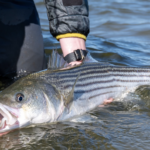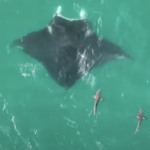
Talkin’ Striped Bass Spawn Dynamics
Consistent spawning production is paramount to a fishery’s long-term health. Many environmental factors are suspected
For the last few years, several scientists, led by Dr. Dave Secor at the University of Maryland’s Center for Environmental Science, have been conducting research on differential migration of striped bass in Chesapeake Bay. Differential migration refers to the increased probability of migration as the size of an individual fish increases. In layman’s terms, the bigger the striped bass, the great chance it migrates out of its natal waters.
In 2014, Dr. Secor’s team surgically implanted a size-stratified sample of 100 Potomac River striped bass with acoustic transmitters. These transmitters, which regularly emit sonic “pings,” are detected by a network of telemetry receivers up and down the coast, a collaborative effort among research institutions known as the Atlantic Coastal Telemetry (ACT) Network. The large number of receivers allowed the scientists to get a clear picture of striped bass migratory habits as displayed in the figure below. The filled circles represent where the tagged Potomac stripers were detected, while the X’s are the locations the fish were implanted. It’s worth noting that in 2015 and 2016 the NY Bight receivers were removed, while from 2015-2018 more receiver arrays were deployed along the DelMarVa shelf.

The movements of the tagged striped bass, based on over 400,000 detections, were recorded for 4 years, which the researchers used to look into seasonal migrations patterns and routes, residency within Chesapeake bay, mortality, and other behaviors such as skipping spawning or straying from previous spawning grounds. All of this information is critical to responsibly managing this iconic species.
There was substantial evidence for differential migration. The study shows that at about 32”, when all male stripers and most females are sexually mature, both males and females leave the Chesapeake Bay and become part of the coastal stock. All of these migratory fish swam to waters off the coast of Massachusetts and returned to areas within Massachusetts Bay and Cape Cod Bays in subsequent years. The threshold size of 32” for joining the coastal stock closely agreed with past studies, although the findings here contradict a previous hypothesis that females leave the Chesapeake at 3 years of age and males remain residents for their entire lives. Yes, most coastal stock stripers are females—but that’s more a function of the fact that more large stripers are females rather than the fact that males are not also migrating. This is a huge finding because Maryland has been allowed to overexploit juvenile striped bass under the false assumption that they primarily catch male fish. Please remember this for all future striped bass discussions.
Because these fish were tagged with acoustic transmitters that last for over 4 years, the scientists are able to infer when a fish dies. If the pings stop coming in, that fish is either no longer alive or has somehow evaded the gauntlet of acoustic receivers and down the coast. Knowing this, Secor’s team was able estimate mortality rates on striped bass. Striped bass living in the Chesapeake Bay—the smaller fish—died at twice the rate of striped bass in the ocean. Please understand that all the scientists know is that the pings stop. You can bet that the anti-catch-and-release crowd will blame this high mortality on discards. However, the other big factors to consider are the prevalence of mycobacteriosis in the Bay, the two fish bag limit in Maryland during this time, and by the same token Maryland’s overfishing of striped bass by over 200% in this interval. It’s hard to imagine that this severe overexploitation wasn’t a bigtime contributor to total mortality in the Bay.
The study certainly answered the question, “When do striped bass leave the Bay?” It also showed us where they go: “The strong connectivity between large Potomac River spawners and feeding aggregations in nearshore waters off Cape Cod and in Massachusetts Bay is remarkable given that 100% of emigrants wind up here after a rapid directional summer transit. Transit times ranged from 17 to 96 days with a mean of 47 days during springs 2014–2018[WG1] .”
All of these new findings has some serious implications on management. It also answers some big unknowns regarding partial migration, which is a serious factor in striped bass resilience: “ Indeed, the dramatic recovery of striped bass in the 1990s was largely due to differential migration, which allowed escapement of large ocean striped bass (i.e., facilitated differential migration) from extremely intense fisheries on smaller individuals within the Chesapeake Bay [71]. Thus, partial migration controls have been implicit in past key management tactics.” In other words, the moratorium allowed several year classes to get the heck out of the Chesapeake. Those big fish faced much lower mortality levels and produced the best spawn ever recorded.
In sum, this new study sheds critical new light on the critical—and complex—nature of striper migrations along the east coast. We’ll be doing our best to ensure that its findings make their way into upcoming striper management discussions, particularly those concerning the Chesapeake Bay.

Consistent spawning production is paramount to a fishery’s long-term health. Many environmental factors are suspected

While the ASGA team is extremely proud of the community we’re building with the Guide

Feature Image: A false albacore being landed off Jupiter Florida by the Cheeky Fishing team,

Feature Photo: “Best Practices for Fishing Cobia Around Manta Rays” The Florida Manta Project is
We rely on our members and donations to keep fighting for a sustainable tomorrow in marine conservation.
By using this website, you agree to our use of cookies. We use cookies to provide you with a great experience and to help our website run effectively. To learn more, please review our privacy policy.